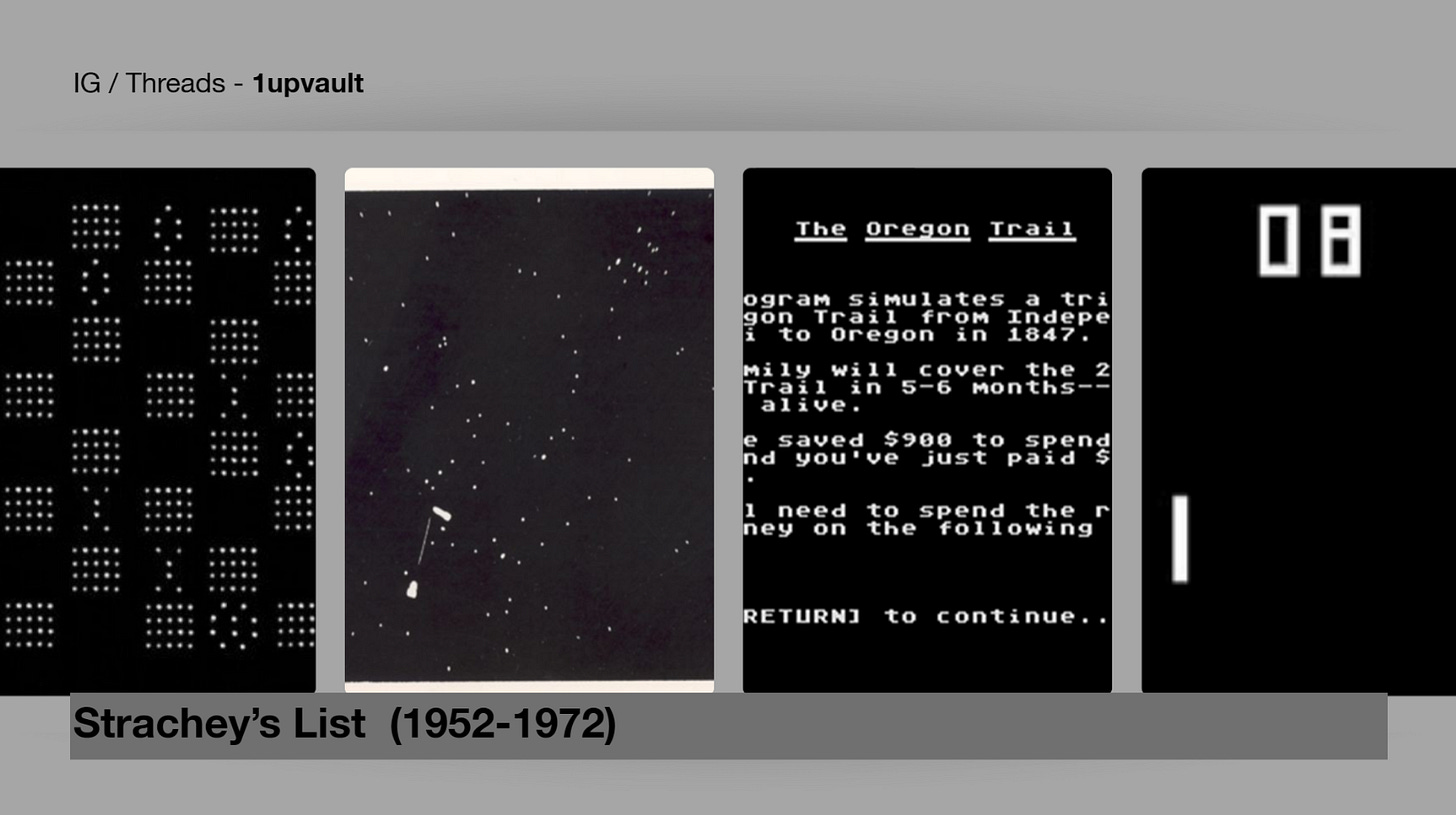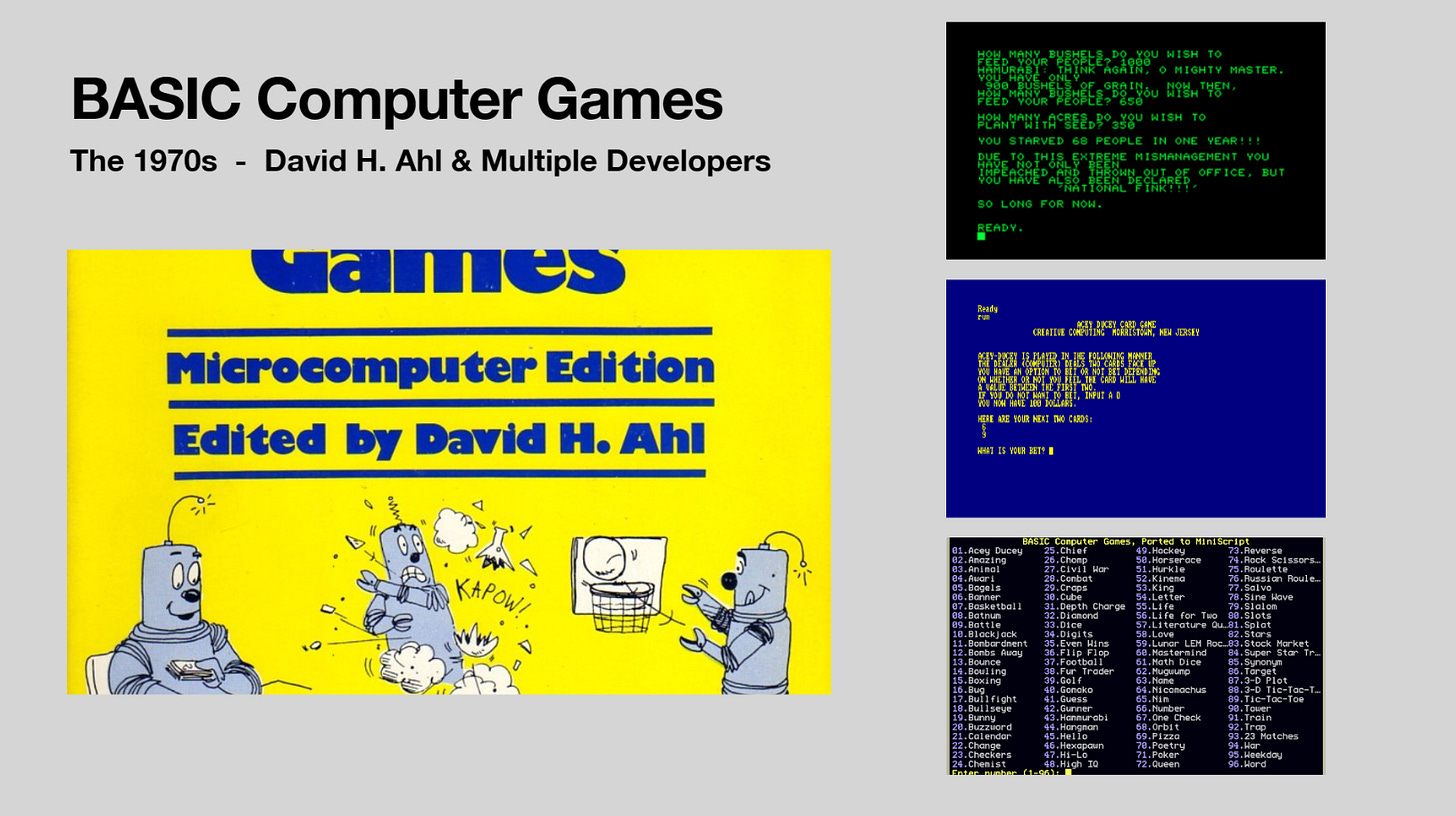1952-1972 saw the first video games, which started as university projects and eventually ended up in the arcade and early computers. Many of these titles have gotten their rightful dues, but some have become lost to many modern gamers’ memories. Strachey’s List is my list of the most acclaimed, consequential, and influential titles of all time. As the series continues, the lists will eventually focus on single years and be limited to 20 games. As always, this is all my opinion and research, especially when I get to more modern stuff.
Draughts
Draughts is the first video game to be developed. It's a simple Checkers game created by Christopher Strachey as a thesis at university. It’s instrumental as the first true playable video game, considering the Cathode Ray-tube Amusement Device was just a concept. Strachey’s contribution to the industry was cemented when making this, which is why this list is named after him. Strachey being gay and British should also be considered when looking at video game history, as it makes video games a theoretical British invention and adds the medium in a big way to LGBTQ+ history.
OXO
Around the same time as Christopher Strachey’s Draughts, Alexander Douglas of the University of Cambridge Created OXO, a simple game of tic-tac-toe. Some have argued that OXO, not Draughts, is the first video game. However, there’s evidence that shows Strachey’s thesis was published before Douglas’. OXO is like other games, such as Bertie the Brain, but that game uses lightbulbs rather than any visual screen.
Tennis for Two
Tennis for Two, the first multiplayer sports video game, was a hit at a three-day college exhibition. Higinbotham was a member of the team that made the first atomic bomb. Looking to create excitement about what technology could do, he made Tennis for Two to have fun at the exhibition. This game introduced multiplayer gaming and is extremely influential in the history of video games. A sequel titled Computer Tennis was released the following year at the exhibition with new features.
Spacewar!
Spacewar! became a staple in colleges nationwide as the people who helped Russel make the game would go to new jobs at universities and clone the game. As a result, this is the first video game played beyond concepts and experiments, though still limited. The game is a space combat title that revolves around a gravity star and two monochrome spaceships that shoot missiles at each other to score a point. The game would have a major influence on many early game designers. In 2007, the game was called one of the most important video games ever. It resembles how Stanley Kubrick’s 2001: A Space Odyssey influenced many would-be movie directors.
Rocket (a.k.a - Lunar Lander)
In the fall of 1969, Jim Storer made a text-based game about the lunar landing, as the Space Age was all the rage worldwide. The game was made for the DEC PDP-8 minicomputer in FOCAL programming. The game launched an early popular genre and multiple iterations, mostly known as Lunar Lander. While future game versions would be much more popular, the original started it all.
BASIC Computer Games
In the 1960s, mainframe computers were used to make simple video games by employees of large corporations or students in colleges. The problem is that these games were specially coded for the device they were made for and came around before the commercialization of video games. Unfortunately, some have been lost to time, but many were ported to computers using the BASIC computer language. Most of these were text-based small games.
In 1971, David H. Ahl began to port a few of these games to the BASIC language. They became a hit after he published the language in the educational newsletter EDU. He asked for submissions and got a bunch from high school students. He went on to publish the book 101 BASIC Computer Games, which contained the games he gathered. Hobbyists with the first microcomputers began to use the book to get the games. It would go on to become the first million copies selling computer book.
Major games included Hamurabi, Lunar Lander, Chomp, Hexawar, and Civil War.
Galaxy Game
One of the first video games to charge money to play it, Galaxy Game was created by Bill Pitts and Hugh Tuck. Heavily inspired by the 1962’s Spacewar!, the game plays with a focus on two spaceships in a dogfight, going around a gravity well. The game became a hit with Stanford University students and has gone on to become known as one of the original, influential video games.
Computer Space
Nolan Bushnell and Ted Dabney's first project was with their new company, Nutting Associates, which would eventually become Atari. Computer Space is yet another game inspired by Spacewar! The game was more successful than Galaxy Game, which became a competitor. This got Bushnell and Atari’s legacy going, and they began establishing the new growing industry.
The Oregon Trail
Don Rawitsch, an 8th-grade history teacher, was working on a school project focusing on mid-19th-century western expansion. He originally planned to make a board game, but his roommates Bill Heinemann and Paul Dillenberger suggested making it into a computer program. This would become The Oregon Trail. The game simulates the western expansion settlers took. Today, the game has gone on to become an important early educational game for many, with different versions and a long-standing legacy. Millennials, in particular, have played the game in schools, becoming a part of their childhood.
Star Trek
Another text-based game that would go on to get many remakes and versions. Star Trek is the first game based on a known franchise, though it never got an official license. The game was made more as a hobby/project, and the idea of making money from games was new. The game follows the USS Enterprise hunting down Klingons in a set time limit. It became a hit and incredibly popular, especially the future Super Star Trek version.
Pong
Arguably the most famous video game ever created. Atari created the first truly huge pop culture hit in the industry with the arcade classic based on ping pong. The game became such a cultural icon, arguably showing “normies” the concept of a video game. The game put Atari and Nolan Bushnell on the map and history. The game would go on to get multiple home variants and start the road to Atari’s eventual home console entry.
Magnavox Odyssey
The first home video game console was very different than what we expect from a video game system. If anything, the Odyssey was more of an interactive board game that used the television. Multiple games based on haunted castles, naming the U.S. states, racing, table tennis, and more were part of it. Despite the weird nature of the system, with its plastic sheets stuck to TV sets using static, the games are the first home console games and established what could be possible for the industry.

















Remake again?